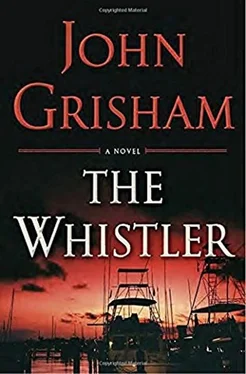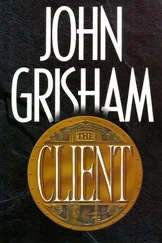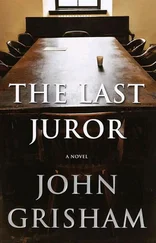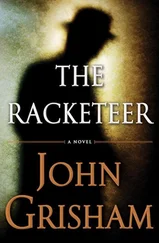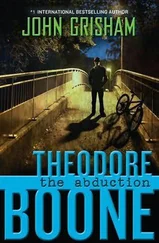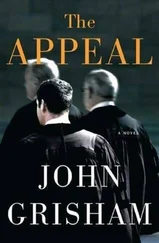Lacy took the plastic bag. “And you have copies?”
“I do, and I have the rest of the paper towel, though no one could ever find it.”
“I don’t know what to say.”
“Say nothing. Just do your job and nail these bastards, and keep my name out of it.”
“I promise.”
“Thank you, Ms. Stoltz. This meeting never happened.” He began walking away, and she said, “Thanks, and I hope your wife is okay.”
“She’s fine. Just a routine checkup. She’s afraid of doctors, so I tag along.”
–
Neither Michael nor Lacy had thought to stick a laptop in a briefcase; otherwise, they would have wheeled into an empty parking lot of a fast-food joint, bought coffees, found a table in the corner, and rolled the footage. Instead, they raced home, speculating nonstop as to what the videos might reveal.
“Why didn’t you ask him?” Michael demanded, with some irritation.
“Because he was in a hurry,” she shot back. “He handed it over, said what he wanted to say, and that was it.”
“I would’ve asked.”
“You don’t know what you would have done. Stop bitching. Who’s the head of the state Department of Law Enforcement?”
“Gus Lambert. He’s new and I don’t know him.”
“Well, who do you know?”
“An old friend.” Michael called the old friend twice and couldn’t get him. Lacy called a girlfriend in the Attorney General’s Office, and got the name of a supervisor with the Regional Crime Lab in Tallahassee. The supervisor was busy and uncooperative and promised to call back tomorrow.
When they were both off the phone, Michael said, “The crime lab won’t do it unless DLE is involved.”
Lacy said, “I’ll call Gus Lambert. I’m sure I can charm his pants off.”
Commissioner Lambert’s secretary was beyond charm, said the boss was in a meeting and was a very busy man. Michael’s old friend called back and asked what was going on. Michael explained, as they blitzed down the passing lane of Interstate 10, that it was an urgent matter dealing with the suspicious death of a state employee. Abbott, the friend, said he recalled the story of the death of Hugo Hatch. Michael said, “We have reason to believe it was more complicated than a bad car wreck. We have a source from within the tribe and we now have possession of a blood sample that could be important. How do we get access to the crime lab?”
As they talked, Lacy searched the web with her phone. Having never dealt with DNA testing, she knew almost nothing about it. According to an article on a science site, forensic technicians are now able to test a suspect’s DNA in two hours, quick enough for the police to ram it through their crime databases and determine if the man in custody has committed the crime in question, as well as others. As recently as five years earlier, the testing took between twenty-four and seventy-two hours, enough time for the suspect to post bail and walk out of jail.
Michael was saying, “No, there’s no open investigation, not by the locals and not by DLE. It happened on tribal land and the Tappacola are in charge. That’s part of the problem. I’m talking about a favor here, Abbott. And a quick one.”
Michael listened, said, “Thanks,” and ended the call. “He says he’ll try and see the commissioner.”
–
It was almost 5:00 p.m. when Michael and Lacy arrived at the DLE’s Regional Crime Lab on the outskirts of Tallahassee. Abbott was waiting at the front door, along with Dr. Joe Vasquez, the head of the lab. Quick introductions were made, and they followed him to a small conference room. Lacy placed the plastic ziplock bag on the table in front of Dr. Vasquez, who looked at it but didn’t touch it.
He asked, “What do we know about this?”
Lacy replied, “Not much. We got it less than two hours ago from our confidential source. He thinks it’s a piece of a paper towel with blood on it.”
“Who’s handled it?”
“We have no idea, but our source considers himself a law enforcement professional. I’d bet it’s been handled very little.”
“How long will it take?” Michael asked.
Vasquez smiled proudly and said, “Give us two hours.”
“That’s incredible.”
“Indeed it is. The technology is changing rapidly, and we think that within two years detectives at the crime scene will be able to check blood and semen with a handheld device. It’s called DNA testing on a chip.”
Lacy asked, “And how long to run the results through the state’s database?”
Vasquez looked at Abbott, who shrugged and said, “Half an hour.”
–
They stopped for Chinese takeout at a favorite spot near the Capitol. BJC was deserted, as they were hoping, when they arrived just after six. Ignoring their dinner, they went straight to Michael’s desktop and plugged in the flash drive. They watched the two videos, printed Gritt’s two-page memo, read it carefully, discussed it line by line, and watched the videos again and again. Lacy was almost numb with the realization that she was looking at the murder weapon, the truck, and perhaps even the murderer, the punk with the bloody nose.
There were two men in each video; all four were different. Could this be the first glimpse of others in the Dubose crime family? They had photos of Vonn entering the condo at Rabbit Run, but no one else. The driver in the second video, the one from Frog’s store, was particularly fascinating. He was older than the other three, perhaps forty-five, and was better dressed, wearing a golf shirt and pressed khakis. He had planned things well enough to attach a set of perfectly faked Florida tags to his truck. He wasn’t Vonn, but could he be a ranking member? Was he in charge of the operation? Could he have been at the scene, with a light, poking around Lacy’s smashed Prius, looking for the cell phones while Hugo was bleeding and dying? Clever as he was, he had made the boneheaded mistake of parking directly in front of Frog’s store and getting himself captured on video. Allie had said more than once that even the smartest criminals do stupid things.
They finally ate cold chicken chow mein, but neither was hungry. Michael’s cell phone rattled at 7:50, and Abbott announced cheerfully, “Got your boy.”
The blood belonged to one Zeke Foreman, a twenty-three-year-old parolee with two drug-related convictions under his belt. His DNA had been in the state’s database for five years, since his first arrest. Abbott had three photos, two of the mug-shot variety and one from the prison archives. He was sending them over by e-mail.
Michael told Abbott he owed him one, and a big one at that, and said thanks.
Lacy was standing by the printer when the three photos rolled off. Michael stopped the second video with a clear shot of both faces. The passenger, even with a bloody nose, looked very similar to Zeke Foreman.
–
Allie Pacheco was more than happy to hustle over to Lacy’s for a late-night drink, though her tone was clearly not romantic. She said it was urgent but offered nothing else. They watched the videos and studied the photos. They read Gritt’s memo and talked about the case until midnight, finishing off a bottle of wine in the process.
Zeke Foreman had been living with his mother near the small town of Milton, Florida, not far from Pensacola. The FBI watched his house for two days but saw no sign of him or his 1998 Nissan. His parole officer said he was due for their monthly checkup on October 4, and he had never missed a meeting. To do so could lead to a revocation and a return to prison. Foreman worked odd jobs and had managed to stay out of trouble for the past thirteen months.
Sure enough, on the fourth Foreman walked into the Probation Office in downtown Pensacola and said hello to his parole officer. When asked where he’d been, he offered a well-rehearsed story of driving a truck for a friend down to Miami. Sit tight, the parole officer said, there are a couple of guys who’d like to say hello. He opened the door, and Agents Allie Pacheco and Doug Hahn walked in and introduced themselves. The parole officer left the room.
Читать дальше
